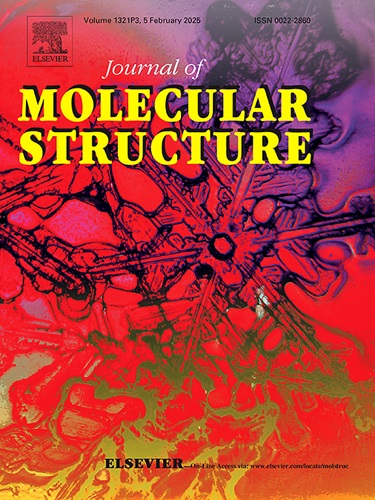Corrosion inhibition and substituent impact of newly synthesized 1,3,4-oxadiazole derivatives on mild steel in acidic media: Electrochemical and quantum chemistry insights
IF 4
2区 化学
Q2 CHEMISTRY, PHYSICAL
引用次数: 0
Abstract
Organic inhibitors are commonly used to protect steel and its alloys from corrosion in acidic aqueous environments. This study evaluates the corrosion inhibition performance of two novel 1,3,4-oxadiazole derivatives 5-(6-chloropyridin-3-yl)-N-(2,6-difluorophenyl)-1,3,4-oxadiazol-2-amine (OXDA1) and 5-(6-chloropyridin-3-yl)-N-(2,6-dimethylphenyl)-1,3,4-oxadiazol-2-amine (OXDA2) on mild steel in 1 M HCl solution. The investigation employed Weight Loss (WL), Electrochemical Impedance Spectroscopy (EIS), and Potentiodynamic Polarization (PDP) methods to assess their anticorrosive properties. Weight loss measurements were conducted at various inhibitor concentrations (10⁻³–10⁻⁵ M) at 308 K. At the optimal concentration (10⁻³ M), OXDA1 exhibited an inhibition efficiency of 88.66 %, whereas OXDA2 achieved 95.02 %. Kinetic and thermodynamic analyses indicated that both OXDAs derivatives undergo physicochemical adsorption on the mild steel surface, functioning as mixed-type inhibitors. Their adsorption behavior followed the Langmuir adsorption isotherm. Theoretical studies (DFT and MD simulations) corroborated experimental findings, identifying reactive inhibitor sites and adsorption mechanisms on mild steel. Experimental and theoretical data led to a proposed inhibition mechanism, demonstrating the compounds’ significant efficacy in mitigating corrosion under acidic conditions.
新合成的1,3,4-恶二唑衍生物在酸性介质中对低碳钢的缓蚀作用和取代基影响:电化学和量子化学见解
有机缓蚀剂通常用于保护钢及其合金在酸性水环境中免受腐蚀。研究了两种新型1,3,4-恶二唑衍生物5-(6-氯吡啶-3-基)- n-(2,6-二氟苯基)-1,3,4-恶二唑-2-胺(OXDA1)和5-(6-氯吡啶-3-基)- n-(2,6-二甲基苯基)-1,3,4-恶二唑-2-胺(OXDA2)在1m盐酸溶液中对低碳钢的缓蚀性能。研究采用失重(WL)、电化学阻抗谱(EIS)和动电位极化(PDP)方法来评估它们的防腐性能。在308 K的不同抑制剂浓度(10⁻³-10⁻5 M)下进行体重减轻测量。在最佳浓度(10⁻³M)下,OXDA1的抑制率为88.66%,而OXDA2的抑制率为95.02%。动力学和热力学分析表明,两种氧化二砷衍生物在低碳钢表面发生了物理化学吸附,具有混合型抑制剂的作用。它们的吸附行为符合Langmuir等温线。理论研究(DFT和MD模拟)证实了实验结果,确定了低碳钢上的活性抑制剂位点和吸附机制。实验和理论数据提出了一种抑制机制,证明了化合物在酸性条件下减轻腐蚀的显着功效。
本文章由计算机程序翻译,如有差异,请以英文原文为准。
求助全文
约1分钟内获得全文
求助全文
来源期刊

Journal of Molecular Structure
化学-物理化学
CiteScore
7.10
自引率
15.80%
发文量
2384
审稿时长
45 days
期刊介绍:
The Journal of Molecular Structure is dedicated to the publication of full-length articles and review papers, providing important new structural information on all types of chemical species including:
• Stable and unstable molecules in all types of environments (vapour, molecular beam, liquid, solution, liquid crystal, solid state, matrix-isolated, surface-absorbed etc.)
• Chemical intermediates
• Molecules in excited states
• Biological molecules
• Polymers.
The methods used may include any combination of spectroscopic and non-spectroscopic techniques, for example:
• Infrared spectroscopy (mid, far, near)
• Raman spectroscopy and non-linear Raman methods (CARS, etc.)
• Electronic absorption spectroscopy
• Optical rotatory dispersion and circular dichroism
• Fluorescence and phosphorescence techniques
• Electron spectroscopies (PES, XPS), EXAFS, etc.
• Microwave spectroscopy
• Electron diffraction
• NMR and ESR spectroscopies
• Mössbauer spectroscopy
• X-ray crystallography
• Charge Density Analyses
• Computational Studies (supplementing experimental methods)
We encourage publications combining theoretical and experimental approaches. The structural insights gained by the studies should be correlated with the properties, activity and/ or reactivity of the molecule under investigation and the relevance of this molecule and its implications should be discussed.
 求助内容:
求助内容: 应助结果提醒方式:
应助结果提醒方式:


